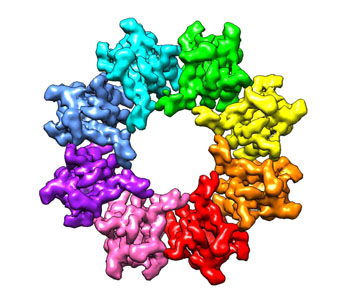Report Describes Mechanism Underlying Genetic Eye Disease
By Gerald M. Slutzky, PhD
Posted on 15 Nov 2016
The molecular mechanism responsible for the genetic eye disease X-linked Retinoschisis (XLRS), which leads to a type of macular degeneration in which the inner layers of the retina split causing severe loss of vision and gradual blindness, was described in a recent publication.Posted on 15 Nov 2016
XLRS is caused by a mutation in retinoschisin, an octameric retinal-specific protein that is essential for the maintenance of the retinal architecture. Investigators at the University of Manchester (United Kingdom) investigated the structure of the retinoschisin monomer and the impact of two XLRS-causing mutants using a combinatorial approach of biophysics and cryo-EM. Cryo-electron microscopy (cryo-EM) allows the observation of specimens that have not been stained or fixed in any way, showing them in their native environment while integrating multiple images to form a three-dimensional model of the sample.

Image: The XLRS is caused by mutations in the retinal protein retinoschisin. The protein plays a crucial role in the cellular organization of the retina, assembling itself to form paired octameric (consisting of eight retinoschisin) rings. The rings each resemble an eight-bladed propeller (Photo courtesy of the University of Manchester).
The investigators reported in the October 23, 2016, online edition of the journal Human Molecular Genetics that the retinoschisin monomer had an elongated structure, which persisted in the octameric assembly. Retinoschisin formed a dimer of octamers with each octameric ring adopting a planar propeller structure. Comparison of the octamer with the hexadecamer structure indicated little conformational change in the retinoschisin octamer upon dimerization, suggesting that the octamer provided a stable interface for construction of the hexadecamer.
The H207Q XLRS-associated mutation was found in the interface between octamers and destabilized both monomeric and octameric retinoschisin. Octamer dimerization was consistent with the adhesive function of retinoschisin supporting interactions between retinal cell layers, so disassembly would prevent structural coupling between opposing membranes. In contrast, cryo-EM structural analysis of the R141H mutation at approximately 4.2 angstrom resolution was found to only cause a subtle conformational change in the propeller tips, potentially perturbing an interaction site.
"We found that one disease-causing mutation sits in the interface between the octamer rings, causing retinoschisin to be less stable," said senior author Dr. Clair Baldock, professor of biochemistry at The University of Manchester. "The other mutation is on the propeller tip which we think is a novel interaction site for other binding proteins in the retina. XLRS is a promising candidate for gene therapy, so our findings on these two different classes of mutations will be informative for future therapeutic strategies."
Related Links:
University of Manchester













